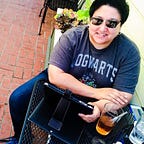Driving Me to Think
Surgeon Pricing
At around midnight I picked up a spinal surgeon who was unusually glad to see me, explaining that he had “been in surgery all day” and was exhausted. He was lovely, with a gentle, comforting voice that anyone would trust. He began immediately talking about some of the cases he had been involved with, including a little girl with an internal decapitation. The girl, who had been in a car crash, had been unable to move at all prior to surgery, but was ultimately able to walk out of the hospital unassisted. “That was the best possible outcome that could have happened” the surgeon beamed, not with pride, but with happiness for the child herself, who would return to her barely-begun life fully functioning.
A case from just that evening involved a quadriplegic who still had sensation in his upper limbs, a good sign that he might at least regain use of his arms. Fascinated, I followed up on his story with loads of questions about the nervous system, connectivity in the human body, and even about surgery itself. How did he decide to specialize in spinal surgery? Where did he do his residency for that? How does he stay focused during long hours? What if he’s eaten something unkind to his digestion and suddenly has to run to the restroom? And so on.
“Dr. Spine” answered all of my inquiries without a hint of indignation, I’m certain because he could tell that I was genuinely interested and was listening attentively to his answers. For that last question, he explained that, should such an urgency arise, he has well-qualified assistants (it’s a teaching hospital) who would be fully capable of stepping in while he was out of the room. However, to avoid ever having to test it, he drinks only caffeinated beverages during working hours and waits until afterwards to drink any water (“I drink about two litres of water as soon as I get home”). He also doesn’t eat anything until he’s done for the day.
That evening, Dr. Spine had also been consulted on a motorcycle crash injury, where the biker had been suddenly cut off by a car that was turning and, as a result, had been thrown some 160 feet away from his motorcycle. “He was a long way from his bike” Dr. Spine added, unnecessarily. Surgery on the biker would be performed the next morning, so Dr. Spine would be scrubbing in at 6:45. Barely six hours from the time we were having the conversation.
This strikes me as very unsafe for surgical patients. For example, long-distance truck drivers, for safety’s sake, are required to stop driving after 14 hours and must have at least 10 consecutive hours off before they are allowed to drive again (we use the same rest rule in filmmaking, by the way). But surgeons, who will literally be holding someone’s life in their hands, often get only a handful of rest time between working shifts.
Of course, it’s obvious that there are only so many surgeons of a particular specialty available, particularly for emergencies; so it comes down to being a simple matter of supply and demand. But how effective can their work actually be if these practitioners have already spent a 14- to 16-hour day in surgery, then have to be back on their feet for another, equally long session less than 6 hours later?
Clearly we need more surgeons, but we also need more equitable access to the training and education required to become a surgeon, with better mentorship and better support for those willing to take on such an incredibly challenging career path in the first place.
